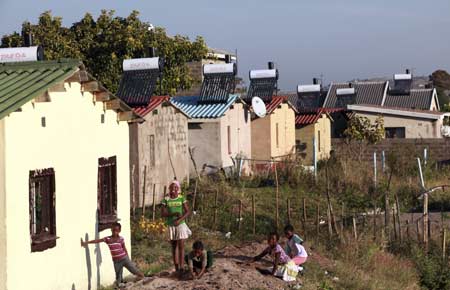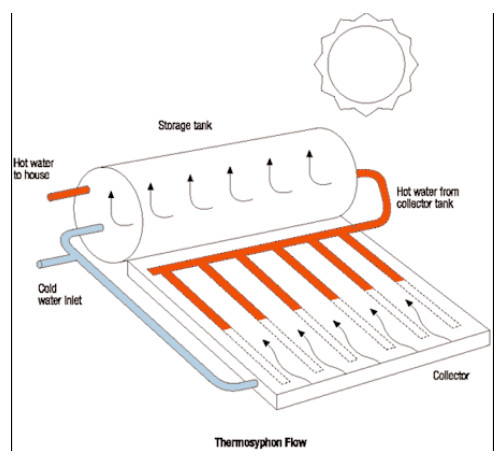Solar water heater tank

A solar water heater is any system that uses the thermal energy of the sun to heat water. They are usually aimed at heating water to a temperature hot enough for washing clothes, washing dishes, and personal hygiene, but not hot enough to cook with straight away. However, as long as it is clean, the hot water can also be used in cooking to save time and fuel.
The basic idea behind the solar water heater is a piece of black piping, filled with water, and laid in the sun for the water to heat up. To heat up more water you increase the number of pipes to make a “collector” and add a tank to store the heated water in. The whole system is insulated to minimize heat-loss. Water is cycled through the collector several times to raise the temperature. Some systems use electric pumps to pump water through the system, but this increases the cost. Alternatively, water can be made to pass through the pipes without a pump using the thermosyphon effect.
Thermosyphons use the fact that hot water rises above cold water. In a passive thermosyphon system, the tank is always above the collector. As the water in the pipes heats up, it rises up into the top of the tank, causing cold water from the bottom of the tank to flow down into the collector. The flow continues until the water in the pipes and the tank is at the same temperature. One-way valves are fitted to stop water flowing back the other way when the temperature drops at night.
Suitable conditions

There are 165 approved India solar water heater manufacturers/suppliers (as at 01 August 2011) and over 1000 companies capable of installing them, and these figures are growing each year, particularly in areas such as Bangalore, Pune, Delhi, Hyderabad, Mumbai and Chennai.1
Benefits
- Heating water with sunshine costs you less. Once you have paid for it, your water heating costs will be zero.
- A solar water heater cannot give you a shock or set fire to your house like electrical or flame-based water heating systems.
- Solar water heaters do not make any smoke, so they don’t make your home smell or get dirty.
- If you usually heat water with gas or electricity from fossil fuels, a solar water heater helps reduce the carbon dioxide produced by your household, helping in the fight against global warming.
Construction, operations and maintenance
Tips on maintaining your tank
- The Size of the Storage Tank: a bigger tank will keep water hotter longer. Homemade tanks are less expensive than commercially bought ones.
- The Surface Area of the Solar Collectors: a bigger surface area for the sun to hit results in more water being heated. In hot climates increase the storage to 2 gallons (7.5 litres) per square foot (0.09 m²). If you don't get this ratio right, there's a possibility that the system will overheat during summer or not heat the water enough during winter.
- Collector Materials Used: traditional (commercial) solar collectors have copper tubing attached to copper heat absorbing fins because this provides the best thermal performance, but at a premium price. Homemade solar water heater collectors can be made at a much lower cost using copper tubes mated to aluminium fins and obtain almost the same performance. Pex tubing/aluminium fins cost about 1/6th the price of commercial ones with approximately 15% loss in performance.
- Tilt Angle and Orientation of Collectors: homemade solar water heater collectors in the Southern hemisphere should face due north and in the Northern hemisphere, due south. The optimal tilt angle you mount the collectors at should be equal to the latitude of your location but the performance difference only becomes noticeable if the angle is more than 10% out.
- Coil Heat Exchanger Material and Dimensions: copper heat exchangers are the best but at a high cost. To make things more affordable a pex/copper hybrid or pure pex heat exchanger is acceptable but they will be less efficient than the copper equivalent. The longer the coil, the more water can be heated at a time, so a 1 inch (2.54 cm) diameter 300 foot (91.44 meters) coil of pipe can hold 12 gallons (45.42 litres) of water, which will be very efficient because many hot water draws are less than that volume.
- Insulation on Tanks and Piping: it's important to insulate properly because the less standby heat lost the longer the water will stay warm and the less the homemade solar water heater system has to work to heat it up again. It also helps to extend the time hot water will be available under cloudy conditions.
- Hot Water Demand: the more hot water you use, the worse your system will perform due to the fact that it has to heat up a larger volume of incoming cold water to the desired temperature.
- Site Obstructions: your commercial and homemade solar hot water collectors should be situated so that they get as much exposure to the sun as possible and that means making sure that obstructions such as trees are taken into consideration before deciding on where to locate them.
- Geographic Location: the closer you get to the equator, the more energy the sun will provide to heat water, due to the fact that the surface of the earth faces the sun directly there.
- Climate: nothing much you can do to alter the weather except move somewhere else but it will have a major performance impact on a commercial and homemade solar water heater due to temperature variations and clouds. NASA estimates that on average worldwide only 57% of the sunlight that strikes the upper atmosphere reaches the earth's surface due to cloud cover and pollution.
Costs
The cost will vary widely around Africa, depending on the size of the system and whether the materials used have to be imported. Import taxes and taxes on business sometimes add to the expense. Governments could help promote solar water heating by reducing taxes for businesses selling solar water heaters. In South Africa in 2005, a 70 litre solar water heating system cost R3000 (US$455). Larger systems with electric back-up cost up to R10000 (US$1520).
Field experiences
India
The Ministry of New and Renewable Energy is responsible for maintaining the standards of solar water heating in India and they provide approval for a number of efficiency test centres around the country such as the School Of Energy Studies , University of Pune.
These efficiency centres conduct solar water heater tests at regular intervals that conform to the specifications set by the Bureau of Indian Standards (BIS).
South Africa
Eskom launched a rebate program for solar geysers in 2008. To qualify for a rebate, all systems need to undergo testing carried out by the South African Bureau of Standards (SABS).
Each one tested by the SABS receives a rating (Q-factor), which indicates the kilowatt-hours (kWh) of electricity it's expected to save on a typical day and the units ability to produce hot water.
Manuals, videos, and links
- MANUAL: WATER FOR EVERYBODY: A Selection of Appropriate Technologies to be used for Drinkable Water, EMAS. The solar water heater section is at the very end of the document under two headings: EMAS pattern solar heater with no tank and Two ways for changing a drum into a tank for hot water in a water heater. By Wolfgang Buchner, 5th edition, 2006.
- ARTICLE: Solar water heaters offer relief to South Africans. June 27, 2011, from chinapost.com.tw
- ARTICLE: Solar Water Heaters Booming in South Africa. MARCH 11, 2011, from sustainablog.org.
- BLOG: Solar Water Blog.

